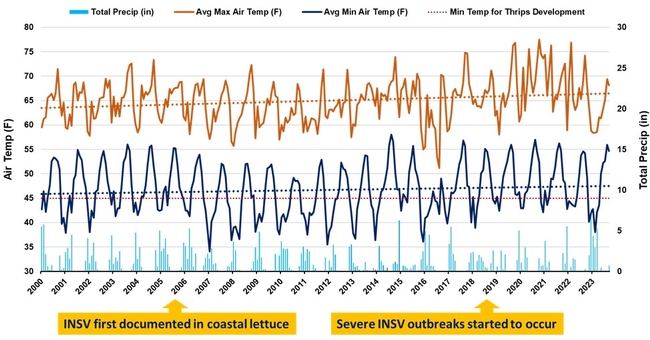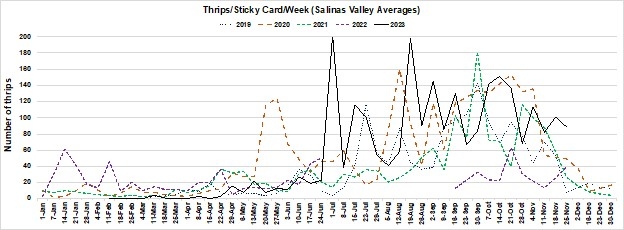Weather, weeds, thrips, and INSV: key points from the 2023 season
Daniel K. Hasegawa
Weather:
- Early 2023 brought historic amounts of precipitation and colder temperatures (Figure 1).
- In contrast to 2023, previous years experienced less precipitation and warmer winters, as observed from 2018 – 2022 (Figure 1).
- Saturated soils delayed much of the lettuce plantings at the beginning of 2023.
Weeds:
- Lots of precipitation led to an abundance of grasses and weeds that germinated during the late winter and early spring.
Thrips:
- Thrips populations recorded from February to April were some of the lowest we have observed since we started the monitoring program. This is a stark contrast to 2022 (Figure 2).
- During the middle and late season (May to November), thrips populations rebounded to levels that we have typically seen in previous years (Figure 2).
INSV:
- Reports of INSV in lettuce were very low during the 2023 season.
So… why were INSV levels so low this year? Our current theory is that the colder weather and precipitation suppressed thrips populations at the early part of 2023. This coincided with an abundance of weeds and grasses that germinated in early 2023. Because the weeds were newly germinated, they were not infected with INSV and thus, served as “clean” hosts for thrips to feed and reproduce on. The thrips that moved out of the weeds and grasses were also “clean”, which led to lower INSV levels in lettuce. Even though thrips populations rebounded to average levels by the month of May, the opportunities for thrips to acquire the virus from infected plants were much lower than in previous years.
For further questions, please reach out to Daniel Hasegawa and Yu-Chen Wang (yckwang@ucanr.edu).
Figure 1: Salinas Valley climate data from 2000 – 2023. Data was obtained from CIMIS 214: Salinas South II station for each month from January 2000 to September 2023 and reported as total precipitation (light blue bars), average maximum air temperature (orange solid line) and overall trend across time (orange dotted line), average minimum air temperature (dark blue solid line) and overall trend across time (dark blue dotted line), and the minimum temperature required for western flower thrips to develop (red dotted line at 45ºF).
Figure 2: Salinas Valley thrips monitoring from 2019 – 2023. Data is reported weekly as the average number of thrips collected per sticky card from 21 locations (Castroville to King City). The data can be viewed in the Salinas Valley Lettuce Pest Mapping Tool, which was developed and managed by Ian Grettenberger and Benjamin Lee (UC Davis).
Desktop version: https://salinaspestmap.shinyapps.io/salinas-pestmap/
Mobile version: https://salinaspestmap.shinyapps.io/salinas-pestmap-mobile/

